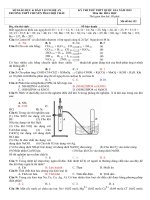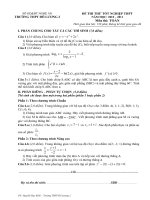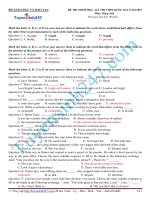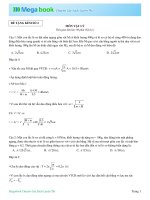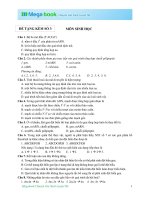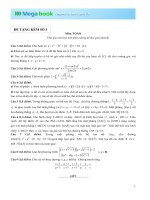- Trang chủ >>
- Đề thi >>
- THPT Quốc Gia
ĐỀ THI THỬ MÔN ANH VĂN Đề minh họa môn Anh BGD năm 2015
Bạn đang xem bản rút gọn của tài liệu. Xem và tải ngay bản đầy đủ của tài liệu tại đây (436.49 KB, 11 trang )
>> Truy cập để học Toán – Lý – Hóa – Sinh – Văn – Anh tốt nhất! 1/11
BỘ GIÁO DỤC VÀ ĐÀO TẠO ĐỀ THI MINH HỌA - KỲ THI THPT QUỐC GIA NĂM 2015
Môn: Tiếng Anh
Thời gian làm bài: 90 phút.
Mark the letter A, B, C, or D on your answer sheet to indicate the word whose underlined part differs from
the other three in pronunciation in each of the following questions.
Question 1: A. drought B. fought C. brought D. bought
Question 2: A. builds B. destroys C. occurs D. prevents
Mark the letter A, B, C, or D on your answer sheet to indicate the word that differs from the other three in
the position of the primary stre ss in each of the following questions.
Question 3: A. include B. achieve C. replace D. comment
Question 4: A. comfortable B. attractive C. secretive D. necessary
Question 5: A. appearance B. telephone C. government D. leadership
Mark the letter A, B, C or D on your answer sheet t o indicate the correct answer to each of the following
questions.
Question 6: By the time their babies arrive, the Johnsons hope _______ painting the nursery.
A. have finished B. finished C. to finish D. finish
Question 7: This is a picture of a _______ bus.
A.red bright London B. bright red London C. London bright red D. London red bright
Question 8: Young people have become increasingly committed ______ social activities.
A. of B. to C. in D. at
Question 9: He ______ to the doctor after the accident, but he continued to play instead.
A. must have gone B. needn’t have gone C. shouldn’t have gone D. should have gone
Question 10: While everybody else in our class prefers working in groups, Mina likes working ______.
A. on herself B. on her own C. of her own D. in herself
Question 11: Marie Curie, ______, was awarded a Nobel Prize for her work.
A.was the scientist who discovered radium B. whose scientific discovery of radium
C. the scientist discovered radium D. the scientist who discovered radium
Question 12: ______ about gene-related diseases has increased is welcome news.
A. Scientific knowledge B. It was scientific knowledge
C. Though scientific knowledge D. That scientific knowledge
Question 13: ______ he arrived at the bus stop when the bus came.
A. Hardly had B. No sooner had C. No longer has D. Not until had
Question 14: _______, the young mother appeared visibly very happy after the birth of her child.
A. Tired as she was B. She was tired C. As tired D. Despite tired
Question 15: John was in Hanoi and wanted to send a parcel to his parents. He asked a local passer-by the
way to the post-office. Choose the most suitable response to fill in the blank in the following exchange. -
John: “Can you show me the way to the nearest post office, please?” - Passer-by: “_______”
A. Not way, sorry. B. Just round the corner over there.
C. Look it up in a dictionary! D. There’s no traffic near here.
Question 16: I knew they were talking about me ______ they stopped when I entered the room.
A.because B. so that C. despite D. therefore
Question 17: Lora has just bought a new skirt that she likes very much. Choose the most suitable response to
fill in the blank in the following exchange. - Jane: “You look great in that red skirt, Lora!” - Lora: “_______”
A. No, I don't think so. B. Oh, you don't like it, do you?
>> Truy cập để học Toán – Lý – Hóa – Sinh – Văn – Anh tốt nhất! 2/11
C. Thanks, I bought it at Macy’s. D. Thanks, my mum bought it.
Question 18: This is ______ the most difficult job I have ever tackled.
A.by rights B. by all means C. by far D. by the way
Question 19: He ______ till the early hours of the next morning listening to pop music.
A.took me up B. kept me up C. caught me up D. held me up
Question 20: His answer was so confusing that it hardly made ______.
A. meaning B. interpretation C. intelligibility D. sense
Question 21: My father sometimes ______ the washing up after dinner.
A. washes B. takes C. makes D. does
Question 22: Waste paper can be used again after being ______.
A.produced B. recycled C. wasted D. preserved
Question 23: Since ______ has been so poor, the class has been closed.
A. attendance B. attendant C. attending D. attendee
Question 24: He was too sure of himself to pay ______ to the warnings against the danger.
A. notice B. attention C. respect D. recognition
Mark the letter A, B, C or D on your answer sheet t o indicate the word(s) SIMILAR in meaning to the
underlined word(s) in each of the fo llowing questions.
Question 25: The rains of 1993 causing the Missouri river to overflow resulted in one of the worst floods of
the 20th century.
A. stopped B. lessened C. caused D. overcame
Question 26: I’m becoming increasingly absent-minded. Last week, I locked myself out of my house twice.
A. being considerate of things B. remembering to do right things
C. forgetful of one’s past D. often forgetting things
Question 27: Many young children are spending large amounts of time watching the TV without being aware
of its detriment to their school work.
A.harm B. advantage C. support D. benefit
Question 28: Ms Stanford is an unusually prolific author. She has written a large number of books these
years, some of which are best-sellers.
A.reflective B. productive C. exhausted D. critical
Question 29: As the enemy forces were so overwhelming, our troops had to retreat to a safer position.
A. powerful B. dreadful C. overflowing D. outgrowing
Mark the letter A, B C or D on your answer sheet to indicate the underlined part that needs correction in
each of the following questions .
Question 30: The collecting of postage stamps is a hobby that interest people of all ages and all walks of life.
A B C D
Question 31: Experts in climatology and other scientists are becoming extreme concerned about thechanges to
our climate which are taking place. A B C D
Question 32: Santa’s transformation began in 1823, when a New York newspaper published the poem A Visit
from Saint Nicholas, that Clement Clark Moore had written to amuse his daughter.
Question 33: It is thought that the unusual warming of the Earth has been caused by so-called greenhouse
gases, such as carbon dioxide, being emitting into the atmosphere by car engines and factories.
Question 34: The world is becoming more industrialized and the number of animal species that have become
extinct have increased.
>> Truy cập để học Toán – Lý – Hóa – Sinh – Văn – Anh tốt nhất! 3/11
Read the following passage and mark the letter A, B , C, or D on your answer sheet to indicate the correct
word or phrase that best fits each of the numbered blanks.
Higher Education in the UK Students who have successfully completed an A-level course may go to
university to do (35)_____ three- or four-year course leading to a first degree such as Bachelor of Arts (BA),
Bachelor of Science (BSc), etc. They apply to several universities which then (36)_____ an offer of a place
specifying the minimum grades the student needs to obtain in the A level subjects studied. Higher education is
not (37)_____. In principle, students have to pay a contribution to the cost of teaching (tuition fees) and have
also to pay their living costs (maintenance). The government provides (38)_____ to help them pay for
university education which have to be paid back from earnings once their income reaches a certain (39)_____.
In recent years government policy has been to (40)_____ the percentage of 18-year olds (41)_____ go to
university, which is now, at 40%, double the 1990 figure, but this growth has been at the (42)______ of the
amount of financial support given to individual students. Universities receive money (43)_____ the state for
each student and are responsible for employing staff and deciding which courses to offer. The head of a
university, who is (44)_____ for its management, is called a vice-chancellor.
Question 35: A. that B. a C. this D. the
Question 36: A. create B. do C. make D. get
Question 37: A. permitted B. allowed C. compulsory D. free
Question 38: A. loans B. hires C. shares D. rents
Question 39: A. grade B. level C. mark D. rank
Question 40: A. rise B. remain C. increase D. decrease
Question 41: A. who B. which C. whose D. whom
Question 42: A. fee B. suspense C. charge D. expense
Question 43: A. of B. from C. to D. in
Question 44: A. liable B. responsible C. answerable D.
chargeable
Read the following passage and mark the letter A, B , C or D on your answer sheet to indicate the correct
answer to each of the question s from 45 to 54.
Early peoples had no need of engineering works to supply their water. Hunters and nomads camped
near natural sources of fresh water, and populations were so sparse that pollution of the water supply was not
a serious problem. After community life developed and agricultural villages became urban centres, the
problem of supplying water became important for inhabitants of a city, as well as for irrigation of the farms
surrounding the city. Irrigation works were known in prehistoric times, and before 2000 BC the rulers of
Babylonia and Egypt constructed systems of dams and canals to impound the flood waters of the Euphrates
and Nile rivers, controlling floods and providing irrigation water throughout the dry season. Such irrigation
canals also supplied water for domestic purposes. The first people to consider the sanitation of their water
supply were the ancient Romans, who constructed a vast system of aqueducts to bring the clean waters of the
Apennine Mountains into the city and built basins and filters along these mains to ensure the clarity of the
water. The construction of such extensive water-supply systems declined when the Roman Empire
disintegrated, and for several centuries local springs and wells formed the main source of domestic and
industrial water.
The invention of the force pump in England in the middle of the 16th century greatly extended the
possibilities of development of water-supply systems. In London, the first pumping waterworks was
completed in 1562; it pumped river water to a reservoir about 37 m above the level of the River Thames and
from the reservoir the water was distributed by gravity, through lead pipes, to buildings in the vicinity.
>> Truy cập để học Toán – Lý – Hóa – Sinh – Văn – Anh tốt nhất! 4/11
Increased per-capita demand has coincided with water shortages in many countries. Southeast
England, for example, receives only 14 per cent of Britain's rainfall, has 30 per cent of its population, and has
experienced declining winter rainfall since the 1980s.
In recent years a great deal of interest has been shown in the conversion of seawater to fresh water to
provide drinking water for very dry areas, such as the Middle East. Several different processes, including
distillation, electrodialysis, reverse osmosis, and direct-freeze evaporation, have been developed for this
purpose. Some of these processes have been used in large facilities in the United States. Although these
processes are successful, the cost of treating seawater is much higher than that for treating fresh water.
From A. Briggs’ article on culture , Microsoft® Student 2008
Question 45: Early peoples didn’t need water supply engineering works because ______.
A.their community life had already developed
B. natural sources of fresh water nearby were always available
C. there was almost no dry season in prehistoric times
D. they had good ways to irrigate their farms
Question 46: The word “impound” in paragraph 1 is closest in meaning to “______”.
A. supply B. irrigate C. provide D. drain
Question 47: Clean water supply was first taken into consideration by ______.
A. the English people B. the ancient Romans C. the Egyptians D. the US people
Question 48: For several centuries after the disintegration of the Roman Empire, the main source of water
supply was from ______.
A. springs and wells B. systems of aqueducts C. dams and canals D. water pipes
Question 49: The word “mains” in paragraph 1 could best be replaced by “______”.
A. lands B. areas C. pipes D. rivers
Question 50: Which of the following is NOT true about London’s water supply in the middle of the 16th
century?
A.Water was pumped from the River Thames. B. Water was stored in a reservoir.
C. Water ran from the reservoir to buildings. D. Water was conducted through canals.
Question 51: The word “vicinity” in paragraph 2 refers to ______.
A. the cities in South-east England B. the areas along the River Thames
C. the neighborhood around a reservoir D. the region where industry developed
Question 52: One of the causes of water shortages in South-east England is ______.
A. water pollution B. increased demand C. water-supply system decline D. water evaporation
Question 53: Which of the following is NOT mentioned as a process of conversing seawater to freshwater?
A. Steaming and cooling. B. Water evaporation.
C. Dissolving chemicals. D. Purification method.
Question 54: In the passage, the author mainly discusses ______.
A. the development of water supply B. the results of water shortages
C. the water pumping systems D. the fresh water storage
Read the following passage and mark the letter A, B , C or D on your answer sheet to indicate the correct
answer to each of the question s from 55 to 64 .
Sleep is a natural process, and although a lot have been written about the subject, it is still surrounded
by mystery. It is used by some as an escape from the world, and regarded by others as an irritating waste of
time: some people get by on very little, others claim they cannot exist without at least ten hours, but nobody
can do without sleep completely.
Our night’s sleep does not just consist of a steady phase of gradually deepening sleep. It alternates
between two stages: Non-dreaming or ordinary sleep, and REM (rapid eye movement) or dreaming sleep. As
>> Truy cập để học Toán – Lý – Hóa – Sinh – Văn – Anh tốt nhất! 5/11
soon as we fall asleep, we go straight into non-dreaming sleep for an hour or so, then into REM sleep for
about 15 minutes, then back into non-dreaming sleep. It alternates in this way for the rest of the night, with
non-dreaming sleep tending to last longer at the beginning of the night. Non-dreaming sleep occupies three-
quarters of our night’s sleep, about a quarter of it deep and the rest fairly light.
It is widely believed that sleep repairs the body and makes good the damage caused by being awake.
However, its main function is to refresh the brain. Experts believe that probably only about two-thirds of our
sleep is necessary for repairing and refreshing the brain, with the most valuable sleep coming in the first few
hours of the non-dreaming period, the last few hours of sleep are not so essential. The brain can manage quite
well with reduced sleep as long as it is uninterrupted sleep.
The quality of sleep is important. A study conducted in the USA looked at short sleepers, who slept
for 5.5 hours on average, and long sleepers, who had 8.5 hours or more. It is discovered after a variety of tests
that the long sleepers were poor sleepers, had twice as much REM sleep as the short sleepers, appeared to
sleep longer to make up for poor sleep, and did not wake up in the morning refreshed. Similarly, people who
sleep deeply do not necessarily get a better quality of sleep than shallow sleepers. Deep sleepers can feel tired
the following day, so six hours of good sleep is worth more than eight hours of troubled sleep.
From Awakening to Sleep – American Psychological Association
Question 55: It can be concluded from the first paragraph that ______.
A. people need equal time of sleep B. sleep remains a puzzle
C. sleep is among the processes of the nature D. everything about sleep has been brought to light
Question 56: The word “irritating” in paragraph 1 is closest in meaning to ______.
A. calming B. soothing C. annoying D. comforting
Question 57: All the following statements are true, EXCEPT for ______.
A. our night’s sleep occurs in a straight line of only two phases
B. all sleeps are similar in the alternatives of the two stages during the night
C. we spend only 25 percent of our night’s sleeping time dreaming
D. we often have no dreams right after we fall asleep
Question 58: The word “it” in paragraph 2 refers to ______.
A. our night’s sleep B. the ordinary sleep C. the REM D. the night
Question 59: The word “occupies” in paragraph 2 could be best replaced by ______.
A. accounts for B. takes care of C. works out D. goes up
Question 60: Unlike the common belief, sleep helps ______.
A. not to be awake C. us to fix the damage happening by day
B. us to repair our body D. our brain to rest and recover
Question 61: The study discussed in the reading passage suggests that ______.
A. the fewer hours we sleep, the more we dream B. deep sleep means better sleep
C. the type of sleep is more important than its length D. six hours of sleep is better than eight hours
Question 62: Which of the following is NOT discussed in the passage?
A. The role of the sleep. B. Sleepless people’s problems.
C. Types of sleep. D. The circle of a sleep.
Question 63: It can be inferred from the reading passage that ______.
A. if we can sleep uninterruptedly, it is not necessary to sleep the whole night
B. REM makes good our brain
C. nearly 70 % of our sleep is invaluable
D. dream enables our body to refresh when we can sleep uninterruptedly
Question 64: This passage is the most likely taken from ______.
A. a doctor’s description B. a health magazine
C. an advertisement D. a fashion magazine
>> Truy cập để học Toán – Lý – Hóa – Sinh – Văn – Anh tốt nhất! 6/11
WRITING
Part I. Finish each of the following sentences in such a way that it means the same as the sentence printed
before it.
Question 65: This is the most interesting novel I’ve ever read.
I have never ……………………………………………………………
Question 66: I can’t cook as well as my mother can.
My mother ……………………………………………………………….
Question 67: The noise next door did not stop until after midnight.
It was not ………………………………………………………………
Question 68: You can ring this number whenever there is any difficulty.
Should …………………………………………………………………
Question 69: “I didn’t break the vase of flowers,” the boy said.
The boy denied ………………………………………………………….
Part II. In about 140 words, write a paragraph about the kind of job you would like to do after you finish
your education.
…………………………………………………………………………………………………………………
…………………………………………………………………………………………………………………
…………………………………………………………………………………………………………………
…………………………………………………………………………………………………………………
…………………………………………………………………………………………………………………
HẾT
>> Truy cập để học Toán – Lý – Hóa – Sinh – Văn – Anh tốt nhất! 7/11
Lời giải chi tiết
1. Đáp án là A. Từ drought có phần gạch chân được phát âm là / au/, các từ còn lại có phần gạch chân được
phát âm là / ɔ:/
2. Theo quy tắc đọc đuôi –s, đáp án là D. Động từ prevent, kết thúc bằng /t/, nên –s được phát âm là /s/; các từ
còn lại phần gạch chân được phát âm /z/
3. Đáp án là D. Danh từ “comment” có trọng âm rơi âm tiết thứ nhất, các động từ còn lại có trong âm rơi âm
tiết thứ hai.
4. Đáp án là B. attractive có trọng âm rơi âm tiết thứ hai, các từ còn lại trọng âm rơi âm tiết thứ nhất.
5. Đáp án là A. appearance có trọng âm rơi âm tiết thứ hai, các từ còn lại trọng âm rơi âm tiết thứ nhất.
6. Đáp án là C. hope to do something: hy vọng làm gì
7. Trật tự các tính từ: Number Opinion Size Age Shape Colour Pattern Origin Material
Purpose NOUN
Với 3 tính từ đã cho: red – màu sắc; bright: sáng – ý kiến, quan điểm; London – nguồn gốc => Đáp án là B
8. Đáp án là B. commit to …: đóng góp, cống hiến
9. should have done: diễn tả hành động đáng lẽ nên xảy ra trong quá khứ ( thực tế không xảy ra ); shouldn’t
have done thì mang nghĩa ngược lại
must have done: diễn tả hành động chắc chắn đã xảy ra trong quá khứ ( có cơ sở );
needn’t have done: diễn tả hành động không cần xảy ra trong quá khứ (nhưng đã xảy ra )
Dựa vào nghĩa có thể chọn đáp án là D. Dịch: Đáng lẽ ra anh ta đã nên đến gặp bác sỹ sau vụ tai nạn, nhưng
thay vì đó anh ta đã tiếp tục chơi.
10. Đáp án là B. Đại từ phản thân : on her own = by herself : một mình cô ấy
11. Câu này hỏi về mệnh đề quan hệ không xác định, giữa hai dấu phẩy.
Dùng phương pháp loại trừ:
A sai , vì was bắt đầu, câu sẽ thiếu chủ ngữ
B sai. Vì câu thiếu động từ
C sai, vì đặt giữa hai dấu phẩy sẽ không hợp lý về mặt ngữ pháp.
Đáp án là D. có thể dùng danh từ “the scientist” ngăn cách giữa hai dấu phẩy để bổ sung cho danh từ trước nó
“Marie Curie” , và “who discovered radium” là mệnh đề quan hệ bổ sung cho danh từ “the scientist”
12. Phân tích câu ta thấy, có hai động từ “has increased” và “is” => A không thể chọn được, vì không thể có
cáu trúc S + V +V.
B cũng loại,vì nếu là câu chẻ, câu nhấn mạnh, ta phải theo công thức: It + be + N + that + S + V.
C cũng loại vì though là liên từ, câu thiếu vế.
Đáp án là D. That + S + V là mệnh đề danh ngữ, có thể đóng vai trò như danh từ đứng đầu câu làm chủ ngữ,
và động từ theo sai chia ở dạng số ít.
13. Đáp án là A. Cấu trúc đảo ngữ: Hardly + had + S + PII + when + ……
Ngoài ra, còn có cấu trúc: No sooner … than…; Not until… that …
14. Đáp án là A. Cấu trúc câu nhượng bộ “ mặc dù … nhưng ”: As + adj + S + V, S+ V.
15. Can you show me the way to the nearest post office, please? – Bạn có thể chỉ cho tôi đường đến bưu điện
gần nhất không? => Câu hỏi về đường
A. Không phải đường, xin lỗi
B. Nó ở ngay góc đằng kia kìa
C. Hãy tra ở trong từ điển
D. Không có giao thông ở gần đây
=> Đáp án là B.
16. Câu này hỏi về liên từ:
Because + clause: bởi vì…(chỉ lý do )
So that + clause : để mà… ( chỉ mục đích )
>> Truy cập để học Toán – Lý – Hóa – Sinh – Văn – Anh tốt nhất! 8/11
Despite + N/V-ing: mặc dù ( chỉ sự tương phản )
Therefore: vì vậy , thường đứng đầu câu, trước dấu phẩy.
Dựa vào nghĩa có thể chọn được đáp án A. Dịch: Tôi biết họ đang nói về tôi vì khi tôi vào phòng họ ngừng
nói .
17. You look great in that red skirt, Lora!” - Lora bạn mặc cái váy đỏ ấy đẹp quá!
A. Không. Tôi không nghĩ vậy.
B. Ồ, bạn không thích nó phải không.
C. Cám ơn. Tôi mua nó ở cửa hàng Macy.
D. Cám ơn. Mẹ của tôi đã mua nó.
Đáp án hợp lý nhất là C.
18. Đáp án là C. By far: từ trước cho tới nay. Dịch: Từ trước tới nay đây là công việc khó nhất mà tôi đã từng
khắc phục.
Các cụm còn lại: By all means: chắc chắn; by the way: bằng cách này,
19. Câu này hỏi về cụm động từ.
Đáp án là C. Catch someone up: ngăn cản ai đi ngủ. Dịch: Anh ta không cho tôi đi ngủ mà giữ cho đến những
giờ sớm của sáng hôm sau để nghe nhạc pop.
20. Đáp án là D. make sense: có nghĩa là hợp lý, có thể hiểu được
21. Đáp án là D. do the washing up: đi rửa bát.
22. Đáp án là B. recycle: tái chế. Dịch: Giấy thừa thải ra có thể được sử dụng lại sau khi đã được tái chế.
Các từ còn lại: produce: sản xuất; waste: lãng phí; preserve: bảo tồn
23. Đáp án là A. attendance: số lượng người tham dự. Dịch: Số lượng người tham dự quá ít, lớp học đã phải
đóng cửa.
Attendant (người phục vụ ) và attendee ( người tham dự ) là hai danh từ chỉ người, tuy nhiên,trong câu này
không dùng được,
Attending ( danh động từ ): sự tham dự - cũng không hợp lý trong câu này.
24. Đáp án là B. pay attention to : chú ý đến…
25. Đáp án là C. result in = cause: gây ra
Các từ còn lại: stop: dừng lại; lessen: làm giảm; overcome: vượt qua…
26. Absent – minded: đãng trí => Đáp án là D. often forgetting things: thường quên mất những điều gì đấy
27. Đáp án là A. detriment = harm: sự gây hại
Các từ còn lại mang nghĩa lợi ích.
28. Prolific: có hiệu suất làm việc cao => Đáp án là B.
Đáp án A. reflective: phản ánh; exhausted: kiệt sức; critical: sâu sắc
29. Đáp án là A. overwhelming = powerful: mạnh
Các từ còn lại: dreadful : sợ hãi; overflowing : chảy mạnh, outgrowing : tăng số lượng vượt trội
30. Đáp án là C. interest => interests, vì động từ chia theo chủ ngữ “that” mà “that” lại thay thế cho “a hobby”
là danh từ số ít, nên động từ phải chia
31. Đáp án là B. extreme => extremely, vì “concerned” như một tính từ => cần một trạng từ chỉ mức độ trước
nó, extremely: cực kỳ
32. Đáp án là C. that => which, sau dấu phẩy là mệnh đề quan hệ không xác định, nên ta không thể dùng
“that” mà dùng “which” để thay thế cho “the poem – bài thơ ”
33. Đáp án là C. emitting => emitted, chia bị động trong trường hợp này, có thể dựa vào cụm “by car engines
and factories”
34. Đáp án là D. have increased => has increased, vì the number of + Ns: chỉ số lượng… => động từ theo
sau phải chia ở dạng số ít.
35. Đáp án là B. danh từ số ít, chưa xác định “three- or four-year course – khóa học 3-4 năm” => dùng mạo từ
“a”
>> Truy cập để học Toán – Lý – Hóa – Sinh – Văn – Anh tốt nhất! 9/11
36. Đáp án là C. make an offer: đưa ra đề nghị
37. Có thể dựa vào câu sau để đoán nghĩa câu trước: “In principle, students have to pay a contribution to …
their living costs (maintenance).”- Về nguyên tắc, các học sinh phải trả khoản đóng góp vào chi phí giảng
dạy (học phí) và cũng phải trả tiền chi phí sinh hoạt của họ (bảo trì).
=> Không thể chọn đáp án C. free: miễn phí; Đáp án A và B giống nhau: permitted = allowed: được cho phép
Do vậy, đáp án là C. compulsory: bắt buộc.
38. Đáp án là A. loans: khoản vay . Dịch: The government provides loans…: chính phủ cung cấp khác khoản
vay ….
Nghĩa các từ còn lại: hires:thuê;shares: cổ phần; rents: tiền thuê
39. Đáp án là B. level:mức độ. Dịch: …. reaches a certain level : đạt đến mức độ ổn định
Nghĩa các từ còn lại: grade: khối; mark: điểm; rank: thứ hạng
40. Đáp án là C. Ngoại động từ: increase + N: tăng … Dịch: government policy has been to increase the
percentage of 18-year olds … go to university – Chính sách của chính phủ là muốn tăng tỷ lệ phần trăm thanh
niên 18 tuổi đi học đại học.
Không dùng được “rise” vì đây là nội động từ, không theo sau bởi tân ngữ
41. Đáp án là A. who thay thế cho “18-year olds- thanh niên 18 tuổi”
42. Đáp án là D. at the expense of…: ở mức chi phí là …
43. Đáp án là B. receive money from : nhận tiền từ….
44. Đáp án là B. be responsible for: chịu trách nhiệm về ….
Nghĩa các từ còn lại: liable chịu trách nhiệm ; answerable: có thể trả lời được; chargeable : có tính phí
45. Đáp án là B. Ý trong bài: Hunters and nomads camped near natural sources of fresh water, and
populations were so sparse that pollution of the water supply was not a serious problem.
46. Đáp án là D. drain = impound: ngăn, rút ( nước )
Supply = provide: cung cấp; irrigate: irrigate: tưới
47. Đáp án là B. Ý trong bài: The first people to consider the sanitation (sư
̣
ca
̉
i thiê
̣
n vê
̣
sinh tốt hơn) of their
water supply were the ancient Romans
48. Đáp án là A. Ý trong bài: The construction of such extensive water-supply systems declined when the
Roman Empire disintegrated, and for several centuries local springs and wells ( suối và giếng ) formed the
main source of domestic and industrial water.
49. Đáp án là C. mains = pipes: những cái ống dẫn
Các từ còn lại: land: vùng đất; area: khu vực; river: sông
50. Đáp án là D. Dựa vào đoạn 2 thì đáp án A, B, C được đề cập: it pumped river water to a reservoir about
37 m above the level of the River Thames and from the reservoir the water was distributed by gravity,
through lead pipes, to buildings in the vicinity.
51. Vicinity: vùng lân cận => Đáp án là C. the neighborhood around a reservoir : vùng lân cận quang hồ
nước
52. Đáp án là B. Ý trong bài: Increased per-capita demand ( nhu câu trên đầu người ) has coincided with
water shortages in many countries.
53. Ý trong bài: Several different processes, including distillation ( chưng cất) , electrodialysis ( thẩm tách
bằng điện), reverse osmosis (thẩm thấu ngược) , and direct-freeze evaporation ( bốc hơi ) , have been
developed for this purpose.
A. Steaming and cooling - Hấp và làm mát.
B. Water evaporation:Bốc hơi nước
C. Dissolving chemicals: Hòa tan hóa chất
D. Purification method. Phương pháp lọc
=> Dễ dàng chọn được đáp án C.
54. A. the development of water supply: Sự phát triển của việc cung cấp nước.
>> Truy cập để học Toán – Lý – Hóa – Sinh – Văn – Anh tốt nhất! 10/11
B. the results of water shortages : Kết quả của việc thiếu nước
C. the water pumping systems: các hệ thống bơm nước
D. the fresh water storage :sự thiếu nước sạch
=> Đáp án phù hợp nhất là A.
55. Đáp án là B. sleep remains a puzzle ( một ẩn số ) . Ý trong bài: Sleep is a natural process, and although a
lot have been written about the subject, it is still surrounded by mystery. Ngủ là một quá trình tự nhiên, và
mặc dù rất nhiều đã được viết về đề tài này, nhưng nó vẫn bao quanh bởi bí ẩn.
56. Đáp án là C. irritating = annoying: gây khó chịu
Nghĩa các từ còn lại: calming: bình tĩnh; soothing : nhẹ nhàng; comforting : dễ chịu
57. Đáp án là A. giấc ngủ ban đêm xảy ra theo một đường thẳng chỉ có hai giai đoạn. Dựa vào ý đoạn 2, ta có
thể thấy, hai giai đoạn mơ và không mơ cứ thay đổi luân phiên trong giấc ngủ, chứ không xảy ra theo một
đường thẳng.
58. Đáp án là A. It = our night’s sleep : giấc ngủ ban đêm
59. Đáp án là A. occupies = accounts for: chiếm
60. Đáp án là D. Ý trong bài: Experts believe that probably only about two-thirds of our sleep is necessary for
repairing and refreshing the brain
61. Đáp án là C. the type of sleep is more important than its length: kiểu giấc ngủ thì quan trọng hơn độ dài
của giấc ngủ.
Dựa vào đoạn cuối trong bài, và câu kết đoạn: … so six hours of good sleep is worth more than eight
hours of troubled sleep.
62. Câu này dễ dàng chọn đươc đáp án B. Sleepless people’s problems. – Vấn đề của những người thiếu ngủ.
Ý này không được đề cập trong bài.
A.Vai trò của giấc ngủ: …. necessary for repairing and refreshing the brain
C. Các loại giấc ngủ: được đề cập ở đoạn cuối
D. Vòng tròn của một giấc ngủ: được đề cập ở đoạn 2.
63. Đáp án là A. Nếu chúng ta có thể ngủ liên tục, thì cần thiết là phải ngủ cả đêm.
Ý trong bài: The brain can manage quite well with reduced sleep as long as it is uninterrupted sleep. - Não có
thể quản lý khá tốt với giấc ngủ được kéo ngắn với điều kiện đó là giấc ngủ không bị gián đoạn.
64. Có thể dễ dàng chọn được đáp án là B. Bài đọc hiểu này lấy ra từ một cuốn tạp chí về sức khỏe.
Các đáp án khác không hợp lý: A. Một đơn thuốc của bác sỹ ; C. Một quảng cáo ; D.một cuốn tạp chí thời
trang
WRITING:
Part 1:
65. I have never read such an interesting novel before. Hoặc: I have never read a more interesting novel than
this (one/ novel).
66: My mother can cook better than I can/ me.
67: It was not until after midnight that the noise next door stopped.
68: Should there be any difficulty, you can ring this number. Hoặc: Should any difficulty arise, you can ring
this number.
69: The boy denied having broken/ breaking the vase of flowers.
Part 2:
Một số chú ý khi viết đoạn văn:
- Bố cục hợp lí rõ ràng phù hợp yêu cầu của đề bài : thường có ba phần: mở , thân, kết
- Sử dụng ngôn từ phù hợp nội dung, đúng văn phong/ thể loại
>> Truy cập để học Toán – Lý – Hóa – Sinh – Văn – Anh tốt nhất! 11/11
- Ngữ pháp, dấu câu, và chính tả, …
Với đề này, có thể dựa vào một số câu hỏi sau để viết bài:
- What job would you like to do after you finish your education?
- Why do you like this job?
- What do you need to do so as to get this job?
Sample:
A job I would like to do after finishing my education would be to work as a foreign correspondent journalist. I
love travelling and learning about other cultures and the way they work, and also the history of other
countries and places around the world. This is the reason why this job attracts me. To become a journalist, I
am trying to learn English well because it is the most popular language in the world. Besides, I will have to
complete a three - four year specialist course with a good certificate at university. Moreover, there are some
particular qualities I think someone would need to do this job such as inquisitiveness, curiosity, confidence,
intelligence, and so on. To sum up, becoming a journalist is my career goal and I will try my best to make it
come true.



